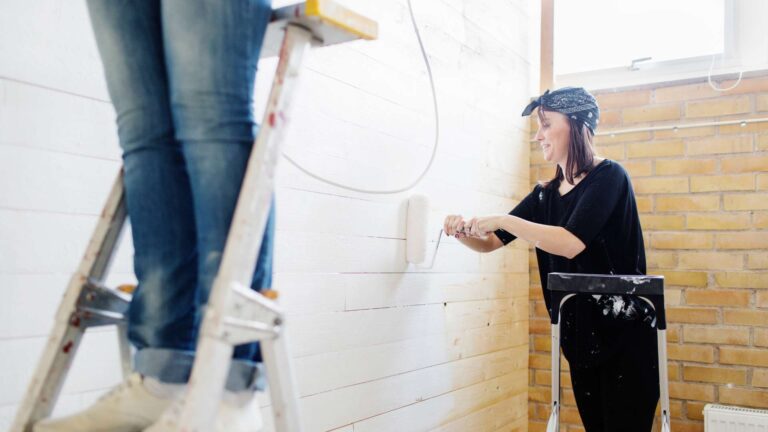Table of Contents
The Hidden Costs Behind Every Housing Choice
When families consider buying or renting, the debate revolves around monthly payments. Is the mortgage cheaper than rent? Will rent hikes outpace equity growth? But there’s another piece of the puzzle that often gets overlooked: the cost (or absence) of maintenance.
Owning a home means you are your own landlord. When the roof leaks, the furnace dies, or the water heater floods the basement, the bill lands squarely on your shoulders. Renting, on the other hand, shifts that responsibility to someone else. One call to the landlord or property manager, and the problem is solved, at no extra charge beyond your rent.
Today, when home prices and repair costs are soaring, this difference has never mattered more. Understanding the true upkeep costs of ownership versus the predictability of renting helps families decide which path fits their finances and their tolerance for surprises.
The True Cost of Home Upkeep
Most homeowners underestimate the time and effort required to keep a property in good shape. Experts recommend annually budgeting 1–3% of the home’s value for maintenance.
- On a $250,000 home: $2,500–$7,500 a year.
- On a $400,000 home: $4,000–$12,000 a year.
And that’s just an average. Some years may only require minor fixes, painting, a leaky faucet, and lawn care. Other years bring massive, unavoidable costs:
- Roof replacement: $8,000–$15,000
- Furnace or HVAC: $4,000–$10,000
- Water heater: $1,500–$3,000
- Foundation repairs: $10,000+
These repairs aren’t optional. They’re the price of keeping a home safe and livable. For families who buy at the top of their budget, even one major repair can throw finances into chaos.
Renting with Maintenance Included: Predictability at a Price
Renters live in a different world. When the roof leaks, it’s not your problem. A broken fridge? Call the landlord. Plumbing failure? A maintenance worker shows up within hours.
The beauty of renting lies in this predictability. Your rent check covers not just your housing but also the responsibility for upkeep. Instead of budgeting thousands for emergencies, renters can focus on other goals, such as paying off debt, saving for a down payment, or investing.
But that peace of mind comes with trade-offs:
- You’re still paying for maintenance indirectly, which is baked into your rent.
- Landlords decide when and how repairs are made (sometimes slowly).
- You don’t control upgrades or improvements; you live with what’s provided.
For families who value stability and hate surprises, renting often feels like paying a premium for peace of mind.
The Psychological Toll of Surprise Repairs
Numbers only tell part of the story. Home maintenance is as much emotional as financial. Few things create stress like an unexpected $5,000 repair in the middle of an already tight year.
Homeowners often describe living with a mental maintenance list: the furnace that could fail, the shingles curling on the roof, the gutters filling with leaves. Even if nothing breaks, the worry alone can weigh heavily.
Renters, by contrast, rarely carry this burden. When something breaks, the solution is simple: report it and wait. That relief, the freedom from worry, is part of the “value” built into rent.
Read related blog: Should You Buy a Fixer-Upper or Rent Move-In Ready?
Long-Term Wealth vs Short-Term Stability
Homeownership comes with headaches, but it also builds equity. Every repair, while costly, preserves the property’s value and protects your long-term investment. A new roof might cost $12,000, but it can extend the life of your home for decades, boosting resale value.
Renters don’t build equity. The money saved from avoiding maintenance must be invested deliberately, or it simply disappears into lifestyle spending. Families who rent wisely, investing the difference into retirement accounts or stock portfolios, can sometimes rival the wealth growth of homeowners. But that requires discipline.
This is the central tension: homeownership trades short-term stability for long-term growth, while renting trades long-term equity for short-term peace of mind.
Regional Differences in Maintenance Costs
Where you live dramatically affects the upkeep vs rent equation.
- In the cold northern states, furnaces, roof snow loads, and frozen pipes drive costs up.
- Southern states: Air conditioning systems strain under long summers, pushing energy and repair bills higher.
- Coastal areas: Salt air corrodes siding, decks, and HVAC systems. Hurricanes or flooding can cause insurance costs to skyrocket.
- Rural areas: Homes with septic tanks, wells, and private roads present unique maintenance challenges that renters rarely consider.
Renters are largely shielded from these regional burdens, while owners must budget specifically for them.
The Hidden “Lifestyle Costs” of Ownership
Beyond repairs, ownership changes how families spend their weekends and emotional energy.
- Time costs: Mowing lawns, raking leaves, shoveling snow, and scheduling contractors.
- Stress costs: Negotiating with service providers, paying deposits upfront, waiting for repairs.
- Opportunity costs: Money tied up in upkeep can’t be used for vacations, education, or investments.
Renters avoid much of this. The landlord’s stress is not theirs. That freedom is why many families, even those who could afford to buy, choose to rent in high-pressure years.
Read related blog: Tax Implications of Renting vs Owning in 2025
Renting with Maintenance: Is It Really “All-Inclusive”?
Many renters believe that “maintenance included” means total freedom. In reality, landlords typically only cover structural and major systems. Tenants are often responsible for:
- Light bulbs, air filters, and minor fixes.
- Lawn care or snow removal (especially in single-family rentals).
- Damage caused by tenants or pets.
“All-inclusive” leases cover everything from utilities to yard care, but usually come at a premium. For careful renters, the peace of mind is worth it. For budget-conscious ones, it may not be.
Homeownership vs Renting
| Factor | Homeownership (Upkeep Costs) | Renting (Maintenance Included) |
| Annual Budget | 1–3% of home value ($3,000–$9,000 on average). | $0 (built into rent) |
| Responsibility | 100% on owner (repairs, upkeep, contractors) | The landlord is responsible for major issues |
| Predictability | Variable, high-risk years with major bills | Predictable, fixed rent |
| Emotional Impact | Stress of repairs, “to-do” lists | Freedom from worry |
| Wealth Growth | Builds equity and resale value | No equity; must invest savings separately |
| Lifestyle | Time and labor are tied to upkeep | More free time, flexibility |
When Maintenance Costs Tilt the Scale
Ownership makes the most sense when:
- You have a strong emergency fund.
- You can comfortably absorb $5,000+ surprises.
- You see the home as a long-term (10+ year) investment.
Renting makes the most sense when:
- Your budget is stretched thin.
- You’re in a period of transition (job, family, location).
- You value time and flexibility over control.
Read related blog: Budgeting for Major Life Changes: Marriage, Baby, and Moving
In the Background of Home Upkeep vs Renting
The Role of Preventive Maintenance in Homeownership
One of the most overlooked aspects of owning a home is the idea of “preventive maintenance.” Just like regular checkups at the doctor save bigger medical bills later, small upkeep tasks prevent massive repair costs.
Cleaning gutters may feel minor, but it can prevent water damage worth thousands. Servicing an HVAC system annually can extend its life by 5–10 years. For many homeowners, the true cost of neglect isn’t visible until it’s too late. Preventive care requires time and money, which renters rarely consider because landlords bear that responsibility.
The difference is that renters live reactively, while owners must live proactively, constantly maintaining to avoid bigger disasters.
Energy Efficiency and Utility Upkeep
Renters often overlook that landlords typically manage the building’s efficiency upgrades. Better insulation, newer appliances, and sealed windows may reduce tenants’ utility bills without them ever having to pay for the upgrades themselves.
Homeowners, however, must shoulder the costs of making their homes efficient. Replacing old windows may cost $12,000, but it could save thousands in heating and cooling over a decade.
Choosing whether to upgrade now or endure higher utility bills later becomes part of the ownership balancing act. Replying to living with what’s provided may be less efficient, but it doesn’t demand upfront investment.
Insurance and Liability Costs: Owner vs Renter
Maintenance costs aren’t only about fixing things but also about liability.
- Homeowners pay for homeowners’ insurance, which covers the building, personal belongings, and liability if someone gets injured on the property. These policies get more expensive as risks (storms, floods, fires) rise. A homeowner with a tree falling on their roof may face a $5,000 deductible before insurance kicks in.
- On the other hand, renters only pay for renters’ insurance, typically $15–$30/month. It covers personal belongings and liability but leaves building issues to the landlord.
This insurance gap means homeowners budget hundreds monthly for coverage, while renters get similar peace of mind for a fraction of the cost.
Resale Value and the ‘Upkeep Premium’
Every dollar a homeowner spends on maintenance isn’t just an expense; it can also preserve or increase resale value. A home with a well-maintained roof, updated HVAC, and fresh paint will command a much higher price than a neglected property.
Renters, however, never see resale value. Their housing payments disappear into the landlord’s equity. That’s why upkeep is often called a “forced savings” for owners: even though it stings upfront, it eventually comes back at sale. The trick is spending strategically on the kinds of upkeep and upgrades that boost value rather than sinking money into purely cosmetic or overly personalized projects.
Stress, Time, and the Human Factor
Numbers rarely capture the human experience of upkeep. For homeowners, every repair means taking time off work to meet contractors, arguing over quotes, or spending weekends on DIY. The time spent is a cost, hours that could have gone to rest, family, or career growth.
Renters, by contrast, offload not just the money but the stress and labor of upkeep. A call to the landlord or property manager resolves the issue, freeing renters from the “mental tax” of home maintenance. For many families, this mental freedom is worth more than the financial cost.
How Beem Helps Families Stay Steady
Whether you’re facing an unexpected repair as a homeowner or a surprise fee as a renter, short-term shocks can derail your plans.
- For homeowners: Beem’s Everdraft™ can cover urgent repair bills, a broken furnace in January, a sudden plumbing disaster, giving you breathing room until you stabilize.
- For renters: Beem bridges sudden rent hikes, deposits, or unexpected fees, ensuring you don’t dip into your savings or derail investment plans.
Beem keeps families steady, no matter which housing path they’re on.
The Real Costs of Housing Responsibility
| Category | Homeowners (Upkeep Budgeting) | Renters (Maintenance Included) | Who Wins? |
| Annual Maintenance | 1–3% of home value ($3K–$9K+) | $0 directly; included in rent | Renters |
| Preventive Upgrades | Owner pays (HVAC, roof, windows) | Landlord covers; renter pays only utilities | Renters |
| Insurance Costs | Homeowner’s insurance ($100–$250/month avg.) | Renter’s insurance ($15–$30/month) | Renters |
| Utility Efficiency | Upgrades cost thousands, savings build over the years | Often enjoy upgrades without paying | Renters (short term), Owners (long term) |
| Resale Value | Upkeep preserves/increases home value | No resale value; money flows to the landlord | Owners |
| Stress & Time | High, must manage repairs, quotes, and scheduling | Low, the landlord handles repairs | Renters |
| Wealth Building | Equity grows with upkeep and appreciation | None unless the renter invests savings | Owners |
Key takeaway: Renting wins for short-term predictability and stress-free living, while ownership wins long-term if families can handle the costs and time investment.
The Bottom Line
Budgeting for upkeep vs renting with maintenance included isn’t just about money; it’s about lifestyle, emotional bandwidth, and risk tolerance. Homeownership can build wealth but requires patience, planning, and resilience to weather the inevitable repairs. Renting may not grow equity, but it buys peace of mind and protects your time.
The right choice depends on what matters most to your family right now. Stability today or wealth tomorrow? With the right strategy and tools like the Beem app’s range of services to cushion the surprises, either path can be a step toward financial confidence. Download the app now!
FAQs on Budgeting for Home Upkeep vs Renting with Maintenance Included
How much should I realistically budget each year for home upkeep?
A good rule of thumb is annually 1–3% of your home’s value. On a $350,000 property, that’s $3,500–$10,500 per year. Some years will be light, with just lawn care or painting. Others, like when a roof or HVAC fails, can blow past your budget.
Do renters ever have to pay for maintenance?
Yes, but usually only for minor fixes or damages they cause. Replacing light bulbs and air filters or fixing tenant-caused damage (like a clogged sink due to improper use) is often the renter’s responsibility. The landlord is responsible for major repairs, roof leaks, plumbing failures, and structural damage.
Is it cheaper to rent than to own once upkeep is factored in?
In the short term, yes. Renters avoid major repair costs and unpredictable bills. Over decades, however, homeowners may come out ahead because upkeep expenses protect equity and resale value. Renting only “wins” financially if renters consistently invest the difference they save.
What’s the emotional cost of upkeep vs renting?
Upkeep brings pride and control for owners but also stress, time loss, and worry over unexpected bills. For renters, there’s less stress day-to-day, less control over the home environment, and no equity growth.
How does Beem help with upkeep or rental shocks?
Beem’s Everdraft™ cushions sudden repair costs for homeowners, whether a furnace breakdown or emergency plumbing. For renters, it bridges gaps caused by sudden rent hikes, new deposits, or unexpected fees. Beem ensures short-term shocks don’t derail long-term stability for either group.














































